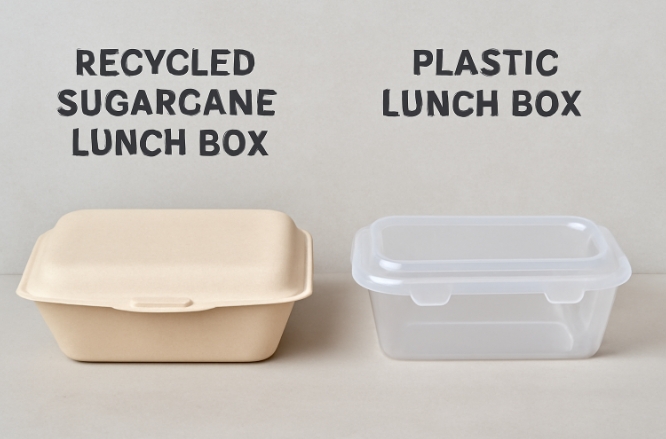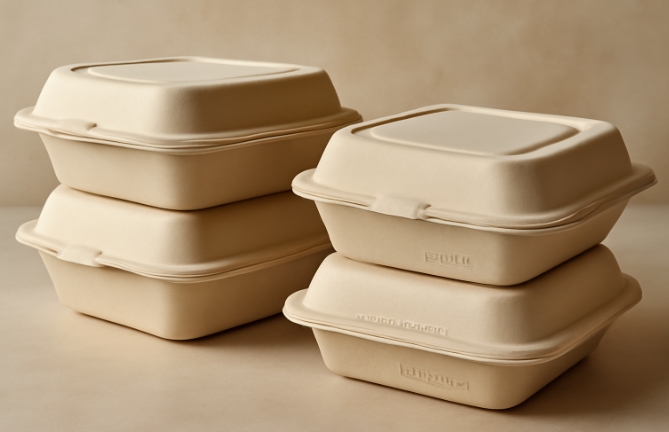
Content Menu
● The Environmental Impact of Packaging Choices
>> The Problem with Plastic Lunch Boxes
>> The Sugarcane Solution
● Why Sugarcane Lunch Boxes Are Better for the Environment
>> Renewable and Sustainable Resource
>> Reduced Carbon Footprint
>> Biodegradability and Compostability
>> Waste Reduction
● Health and Safety Advantages
>> Non-Toxic and Food Safe
>> Microwave and Freezer Safe
>> Sturdy and Leak-Proof
● Practical Benefits for Businesses and Consumers
>> Enhancing Brand Image
>> Customization and Versatility
>> Space and Cost Efficiency
>> Safe for Multiple Uses
● The Circular Economy: Closing the Loop
>> From Waste to Resource
>> Supporting Global Sustainability Goals
● Comparing Sugarcane vs. Plastic Lunch Boxes
● Addressing Common Concerns
>> Is Sugarcane Packaging as Durable as Plastic?
>> What About Cost?
>> How Should Sugarcane Lunch Boxes Be Disposed Of?
>> Are There Any Limitations?
● Conclusion
● Frequently Asked Questions (FAQ)
>> 1. What is a recycle sugarcane takeaway disposable lunch box made from?
>> 2. Are sugarcane lunch boxes safe for microwaving and freezing?
>> 3. How do I dispose of a recycle sugarcane takeaway disposable lunch box?
>> 4. Can sugarcane lunch boxes be customized with logos or branding?
>> 5. Are there any allergens or toxins in sugarcane lunch boxes?
The global movement toward sustainability is reshaping how we eat, travel, and live. One of the most visible changes is in food packaging. As consumers and businesses seek alternatives to single-use plastics, the recycle sugarcane takeaway disposable lunch box has emerged as a leading contender. But what makes these eco-friendly containers superior to traditional plastic lunch boxes? This article explores the environmental, practical, and health benefits of choosing recycled sugarcane disposable lunch boxes over plastic, and why this shift matters for our planet and future generations.

The Environmental Impact of Packaging Choices
The Problem with Plastic Lunch Boxes
Plastic lunch boxes have long been the default choice for takeaway and food delivery. However, their environmental impact is severe. Plastics are derived from non-renewable fossil fuels, require significant energy to produce, and can persist in the environment for centuries. Most plastic disposables are non-biodegradable, contributing to overflowing landfills, ocean pollution, and harm to wildlife. Even when recycled, plastics often degrade in quality and cannot be recycled indefinitely, leading to eventual waste accumulation.
The Sugarcane Solution
In contrast, the *recycle sugarcane takeaway disposable lunch box* is made from bagasse-the fibrous residue left after extracting juice from sugarcane. This material is a byproduct of sugar production, meaning its use does not require additional land or resources. Instead of being burned or discarded, bagasse is transformed into sturdy, compostable containers. These lunch boxes are fully biodegradable and break down within a few months in composting conditions, returning nutrients to the soil and supporting a circular economy.
Why Sugarcane Lunch Boxes Are Better for the Environment
Renewable and Sustainable Resource
Sugarcane is a rapidly growing crop, harvested annually in tropical and subtropical regions. Using bagasse for packaging maximizes the value of each sugarcane harvest and provides farmers with an additional revenue stream. Unlike trees, which can take decades to mature, sugarcane's fast growth makes it a highly renewable resource.
Reduced Carbon Footprint
The manufacturing process for *recycle sugarcane takeaway disposable lunch box* products emits less carbon dioxide than plastic or paper alternatives. Since bagasse is a waste product, its repurposing avoids the environmental costs of sourcing new raw materials. Additionally, sugarcane plants absorb carbon dioxide as they grow, further offsetting emissions.
Biodegradability and Compostability
Sugarcane lunch boxes are certified biodegradable and compostable. They break down in commercial composting facilities within a short period, and even faster in some home composting systems. Unlike plastics, which can take centuries to decompose and often release harmful microplastics, sugarcane containers return safely to the earth without leaving toxic residues.
Waste Reduction
By choosing *recycle sugarcane takeaway disposable lunch box* options, businesses and consumers help divert agricultural waste from landfills and incinerators. This not only reduces overall waste but also supports a more sustainable, circular economy where materials are reused rather than discarded.
Health and Safety Advantages
Non-Toxic and Food Safe
Plastic containers can leach harmful chemicals, especially when exposed to heat or acidic foods. Substances like BPA and phthalates, commonly found in plastics, have been linked to health concerns. In contrast, sugarcane lunch boxes are naturally free from these toxins. They are manufactured under strict food safety guidelines and do not impart any taste or odor to food.
Microwave and Freezer Safe
*Recycle sugarcane takeaway disposable lunch box* products are highly versatile. They can withstand both hot and cold temperatures, making them safe for microwave reheating and freezer storage. This convenience is often lacking in traditional plastic or foam containers, which may warp, melt, or release chemicals when heated.
Sturdy and Leak-Proof
Despite being plant-based, sugarcane lunch boxes are strong, durable, and resistant to oil and moisture. They can securely hold hot, cold, wet, or greasy foods without leaking or breaking down, making them suitable for a wide range of culinary applications.
Practical Benefits for Businesses and Consumers
Enhancing Brand Image
As consumers become more eco-conscious, businesses that adopt *recycle sugarcane takeaway disposable lunch box* solutions demonstrate their commitment to sustainability. This can enhance brand reputation, attract environmentally aware customers, and even provide a competitive edge in the foodservice industry.
Customization and Versatility
Sugarcane containers are available in various shapes and sizes, including clamshells, trays, and bento boxes. Many suppliers offer customization options, allowing businesses to add branding or logos to their packaging. These lunch boxes are stackable, easy to transport, and suitable for both dine-in and takeaway services.
Space and Cost Efficiency
Lightweight and easy to stack, sugarcane lunch boxes simplify storage and transportation. Their durability reduces the risk of spills or damage during delivery, potentially lowering costs associated with food waste or packaging failures.
Safe for Multiple Uses
Although designed for single use, many sugarcane lunch boxes can be wiped clean and reused several times if not heavily soiled. This adds an extra layer of practicality for both businesses and consumers.

The Circular Economy: Closing the Loop
From Waste to Resource
The recycle sugarcane takeaway disposable lunch box exemplifies the principles of the circular economy. By repurposing agricultural byproducts into valuable packaging, we reduce reliance on virgin materials and minimize waste. After use, these lunch boxes decompose naturally, enriching the soil and supporting new plant growth-a closed-loop system that benefits the environment at every stage.
Supporting Global Sustainability Goals
Switching to sugarcane-based packaging aligns with international sustainability targets, including reducing plastic waste, lowering greenhouse gas emissions, and promoting responsible consumption and production. As more businesses and consumers make the switch, the positive impact on the planet grows exponentially.
Comparing Sugarcane vs. Plastic Lunch Boxes
| Feature | Recycle Sugarcane Takeaway Disposable Lunch Box | Plastic Lunch Box |
| Material Source | Bagasse (renewable, byproduct) | Petroleum (non-renewable) |
| Biodegradability | Yes | No |
| Compostable | Yes | No |
| Toxins | None | Possible (BPA, phthalates) |
| Microwave Safe | Yes | Sometimes (risk of leaching) |
| Freezer Safe | Yes | Sometimes |
| Oil/Water Resistance | Yes | Varies |
| Environmental Impact | Low | High |
| Customization | Yes | Yes |
| Reusability | Limited (can be wiped clean) | Sometimes |
| Cost | Competitive, often decreasing | Varies |
Addressing Common Concerns
Is Sugarcane Packaging as Durable as Plastic?
Yes. Modern *recycle sugarcane takeaway disposable lunch box* designs are engineered for strength and leak resistance. They perform as well as, or better than, many plastic alternatives, especially for hot, oily, or heavy foods.
What About Cost?
While sugarcane packaging may have been more expensive in the past, increased demand and improved manufacturing have made it cost-competitive with plastic. Additionally, the environmental and branding benefits often outweigh any small price differences.
How Should Sugarcane Lunch Boxes Be Disposed Of?
For maximum environmental benefit, these lunch boxes should be composted in home or industrial composting facilities. If composting is not available, they will still break down far faster than plastic in landfill conditions.
Are There Any Limitations?
Sugarcane lunch boxes are not suitable for long-term storage of liquids, as they may eventually absorb moisture. However, for standard takeaway and delivery use, they are highly effective.
Conclusion
The choice between a *recycle sugarcane takeaway disposable lunch box* and a plastic lunch box is about more than convenience-it's a decision that impacts the environment, public health, and the future of our planet. Sugarcane lunch boxes offer a renewable, biodegradable, and non-toxic alternative that meets the needs of modern consumers and businesses alike. By making the switch, you support a circular economy, reduce waste, and contribute to a cleaner, greener world. The next time you reach for a takeaway container, consider the benefits of sugarcane-and help lead the way toward sustainable living.

Frequently Asked Questions (FAQ)
1. What is a recycle sugarcane takeaway disposable lunch box made from?
A recycle sugarcane takeaway disposable lunch box is made from bagasse, the fibrous residue left after extracting juice from sugarcane. This material is a renewable, plant-based byproduct that is molded into sturdy, compostable containers.
2. Are sugarcane lunch boxes safe for microwaving and freezing?
Yes, sugarcane lunch boxes are both microwave and freezer safe. They can withstand high temperatures for reheating food and low temperatures for food storage without losing their integrity or leaching harmful chemicals.
3. How do I dispose of a recycle sugarcane takeaway disposable lunch box?
The best way to dispose of a sugarcane lunch box is through composting, either at home or in an industrial facility. If composting is not available, they can be safely discarded with regular waste, where they will decompose much faster than plastic.
4. Can sugarcane lunch boxes be customized with logos or branding?
Yes, many suppliers offer customization options for recycle sugarcane takeaway disposable lunch box products. Businesses can add their logo, brand colors, or other designs to enhance their brand image and promote sustainability.
5. Are there any allergens or toxins in sugarcane lunch boxes?
No, sugarcane lunch boxes are naturally free from common allergens and do not contain harmful chemicals such as BPA or phthalates. They are food-safe and do not impart any taste or odor to the food they contain.

















